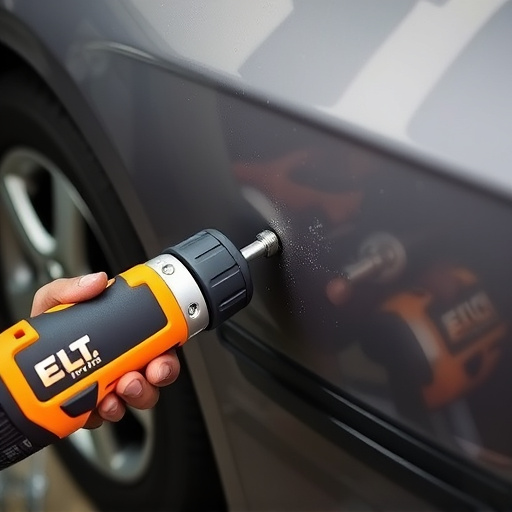Regular Tesla thermal management checks using diagnostic tools ensure optimal cooling and component health, preventing costly repairs. This process involves evaluating cooling systems, temperature monitoring, and addressing issues like leaks or insulation inefficiencies through expert interpretation for peak vehicle performance and safety.
“Tesla vehicles are renowned for their cutting-edge technology, and efficient thermal management is key to optimal performance. This article explores how to perform a thorough Tesla thermal management check using diagnostic service tools. We’ll delve into the intricate system that regulates temperature, highlighting the importance of regular checks. By understanding the process and utilizing the right tools, owners can ensure their Teslas remain in peak condition, maintaining both efficiency and safety in all driving conditions.”
- Understanding Tesla's Thermal Management System
- Tools for Efficient Thermal Management Diagnosis
- Step-by-Step Guide: Performing a Thermal Check
Understanding Tesla's Thermal Management System

Tesla’s thermal management system is a sophisticated network designed to maintain optimal temperatures across various components, ensuring both vehicle performance and safety. At its core lies a complex interplay of sensors, radiators, and pumps that work in harmony to regulate heat distribution. This intricate system is essential for managing the high-performance electric motors and batteries found in Tesla vehicles, which generate significant heat during operation.
A Tesla thermal management check using diagnostic service tools allows technicians to thoroughly evaluate this critical system. By accessing real-time data from sensors embedded throughout the vehicle, auto body shops and collision damage repair centers can identify any anomalies or inefficiencies. This proactive approach to thermal management is crucial not only for preventing potential failures but also for ensuring that restored car bodies, especially after repairs like those involved in car body restoration, operate at peak efficiency, maintaining the vehicle’s overall performance and longevity.
Tools for Efficient Thermal Management Diagnosis

In the realm of Tesla thermal management check, diagnostic service tools play a pivotal role in ensuring optimal vehicle performance and longevity. These advanced tools are designed to efficiently diagnose and address issues related to a Tesla’s thermal system, which is crucial for maintaining top-notch efficiency and safety standards. Modern diagnostic software can pinpoint problems within the cooling system, battery management, and other critical components, enabling quick and precise repairs.
Efficient thermal management diagnosis relies on a suite of specialized tools that go beyond basic auto maintenance. Features like temperature sensors, pressure monitors, and predictive analytics help mechanics detect anomalies early, preventing minor issues from escalating into costly bumper repairs or necessitating frequent tire services. By leveraging these diagnostic capabilities, Tesla owners can rest assured their vehicles are running at peak thermal efficiency, enhancing both driving experience and the overall health of their electric powertrains.
Step-by-Step Guide: Performing a Thermal Check

Performing a Tesla thermal management check is crucial for maintaining optimal vehicle performance and safety. Here’s a step-by-step guide to help you diagnose potential issues with your Tesla’s thermal system using diagnostic service tools.
1. Power On and Select Menu: Start by powering on your Tesla and navigating to the diagnostics menu using the center display. Ensure the vehicle is in Park mode for accurate readings.
2. Access Thermal Management Options: Use the menu options to access specific tests related to thermal management. Look for labels like “Cooling System Check” or “Temperature Monitoring.”
3. Initiate Thermal Check: Initiate the thermal check by following the on-screen prompts. This process may involve running the engine and allowing it to reach operating temperature while monitoring various sensors and system parameters.
4. Review Diagnostic Results: After the test is complete, review the diagnostic results for any error codes or anomalies. Pay close attention to temperatures readings from key components like the engine, transmission, and battery.
5. Identify Potential Issues: High temperature discrepancies may indicate problems with coolant leaks, faulty radiators, or inefficient thermal insulation. Low temperatures could signal blockages in the cooling system or insufficient charging of the battery.
6. Consult a Professional: If you encounter any issues or are unsure about interpreting the results, consult a qualified auto body repair shop or Tesla service center for expert assistance. They have access to advanced body shop services and frame straightening techniques to address thermal management problems effectively.
Performing a thorough Tesla thermal management check using diagnostic service tools is essential for maintaining optimal vehicle performance and safety. By understanding Tesla’s advanced thermal system and leveraging the right tools, you can efficiently diagnose and address any issues. Following this step-by-step guide enables car owners and technicians to stay ahead of potential problems, ensuring a cool and controlled driving environment for years to come. For a seamless experience, incorporate these practices into regular maintenance routines.














